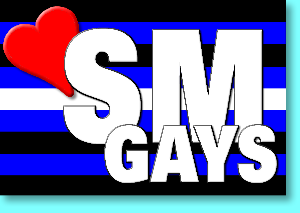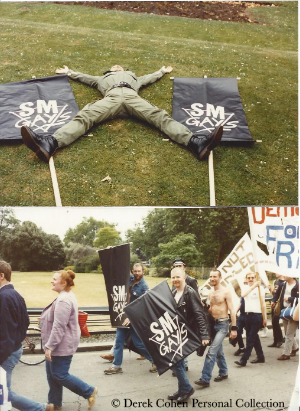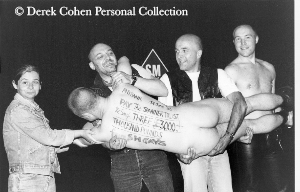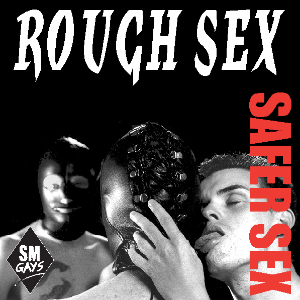SM Gays – By Derek Cohen
 SM Gays is an organization started in London in 1981 for, as its name indicates, gay men interested in the practice of SM sex. Created in the wave of the sexual liberation movement of the 1970s, SM Gays continued the path of SM liberation started by the foundation of The Eulenspiegel Society (now TES) in New York City, in 1971, and then amplified by The Society of Janus from the mid-1970s in the Bay Area. Samois, the first lesbian SM organization started in 1978 also in the Bay Area; and most importantly Gay Male S/M Activists, or GMSMA, started in August 1980 in New York City which was, as we shall see, a more direct influence on SM Gays.
SM Gays is an organization started in London in 1981 for, as its name indicates, gay men interested in the practice of SM sex. Created in the wave of the sexual liberation movement of the 1970s, SM Gays continued the path of SM liberation started by the foundation of The Eulenspiegel Society (now TES) in New York City, in 1971, and then amplified by The Society of Janus from the mid-1970s in the Bay Area. Samois, the first lesbian SM organization started in 1978 also in the Bay Area; and most importantly Gay Male S/M Activists, or GMSMA, started in August 1980 in New York City which was, as we shall see, a more direct influence on SM Gays.
SM Gays, like all the aforementioned organizations, inherited from Eulenspiegel the triadic model around which their activities would revolve: social, educational, and political. SM Gays was created as a place where gay men with an interest in BDSM could meet one another socially, where they could learn from one another in order to enjoy and extend their favorite BDSM activities safely and with greater intensity, and where they could organize and agitate in order to dispel myths around SM or fight against legal infringements on the rights of SM practitioners.
40 years after its creation, the organization is still thriving and it has become a central feature of the London SM scene. Indeed, it took the COVID crisis to interrupt its regular monthly meetings. As with all the other SM organizations born out of the radical 1970s, the social and educational functions have remained more central whereas the political activity has often receded. But SM Gays did have its political moment in the 1990s when, in the context of the infamous Operation Spanner, which led to the Spanner Case, one of the most egregious legal attacks on SM sex in recent history, SM Gays came to play a prominent political role in what remains to date the most important political mobilization in the world by and for SM people.
***
SM Gays was started in 1981 by Derek Cohen as the “S&M Support Group” — it became SM Gays in the late 1980s. The names — the initial one as well as the later one — designate the organization as a creation of the 1980s. Indeed, before 1980, primarily to escape legal scrutiny or unwanted attention, SM organizations had all used names designed to camouflage their real purpose: Eulenspiegel was a reference to a character of German folklore who had been described by psychoanalyst Theodor Reik as a seeker of pain; Janus referred to the versatility of the Roman God of portals; and Samois was an allusion to the town where the main protagonist of Story of O was made to submit to other women. Even the primary institutional forms of gay male SM — the motorcycle club and the leather bar — speak to the contradictory needs of making SM visible and of concealing it. Motorcycle clubs and biker culture were real in many cases, but in many others, both in Europe and in North America, the reference to “motorcycle” was simply a cover for SM. And while many SM players were genuinely leather fetishists, leather was also a covert way to signal SM proclivities and several “motorcycle clubs” were never about motorcycles.
By the early 1980s, SM activism had entered into a new phase and the first sign of it was the creation of GMSMA — the first SM organization that explicitly included SM in its name. Not coincidentally, it was upon reading in The Body Politic (a Toronto-based lesbian and gay newspaper that was particularly popular among “movement gays and lesbians,”) that an organization for gay men into SM was being set up in New York City that Derek got the idea of starting something similar in London. The then “S&M Support Group” was thus the second organization that had an explicit reference to SM in its name.
But for Derek, referring explicitly to SM was necessary for yet another reason. Throughout the 1970s, leather had been a common way for gay men to signal SM sex, but it had also been adopted by gay men more broadly simply to signal butchness — in contrast to the stereotypes of gay men as effeminate and sissies. Leather was not used to signal SM sex and some even resented the implication. This use of leather to signal two different things was a source of confusion and frustration. It was assumed by many that if you wore leather you were into BDSM and if you were into BDSM you had to wear leather.
Derek had experienced this problem many times. On his many visits and cruising attempts inside and outside the leather bars of London in the late 1970s he quickly discovered that most of the men in leather weren’t into BDSM. What they were after was a good fuck. Even a pair of handcuffs hanging from their belt was not a reliable sign: in many cases, it merely added to the image of masculinity.
Derek did wear leather, partly to fit in and also because he rode a motorbike daily as his primary means of travel. But he was not a leather fetishist. What turned him on was not leather; it was BDSM. And so leather, instead of functioning as an idiom that got him the sexual partners he wanted, worked as a source of misunderstanding that resulted in disappointing sexual encounters. That experience meant that the organization he was going to create could not afford euphemism at the risk of misunderstanding: it needed to call it like it is; he needed to call it SM.
Derek’s interest in BDSM was known amongst his social circle and a friend invited him to run a workshop in a series he was organising in the summer of 1981.
In front of more than 30 men and women gathered in a room above a pub in North London, Derek went through the basics of SM: what it was (fun, play, consensual) and what it wasn’t (violence, abuse).
He illustrated his presentation with a set of images taken from his extensive porn magazine collection (this was pre-internet, remember) ranging from bondage, Masters and slaves through to pain play and scat.
The discussion that ensued was heated, with many enjoying the opportunity for the first time to openly discuss their BDSM interests. There was hostility too, with one woman famously saying that as far as she was concerned the more men beat each other up the better.
After the workshop, Derek collected names and contact details for people interested in continuing the discussion. A number of the participants met later at his house in South London, where they had a varied discussion about their experiences. Amongst the attendees at that first event was LHOF inductee Jim/Maurice Stewart. Another attendee was known professionally as “Teddy Testicles” as he did a cabaret act, probably for stag/hen/bachelor/bachelorette parties which involved him hanging large weights off his balls.
The group met again and the meetings of what became the S&M Support Group gradually became regular, with the participants taking turns to host them in their home. Over time, they learned and experimented with bondage, caning, mummification, cbt, tit work, etc. Maurice contributed a lot about his experience of making and using the bondage equipment he made and often loaned it for demonstrations.

A demo of mummification and hot wax
at one of the early meetings of SM Gays
These early meetings established the tradition of meeting on the third Wednesday or Thursday of each month — a tradition that only COVID 19, almost 40 years later, was able to interrupt!
For the first few years, the meetings took place in members’ homes and then in private rooms above pubs. This changed in 1985, when the city council-funded London Lesbian and Gay Centre (LLGC) opened and what was not yet called SM Gays tried to book a meeting room. This gave way to controversies similar to the ones that occurred a couple years before, when Samois tried to meet in the Women’s Building in San Francisco, or when, around the same time, GMS/MA tried to meet in the then Lesbian and Gay (now LGBT) Community Center in New York City. SM was described as patriarchal or downright Nazi by those who opposed its admission to the LLGC. Another campaign also sought to keep bisexual groups outside of the LLGC. But in the end, a vote took place, inclusivity prevailed, and like GMSMA, but unlike Samois, SM Gays was able to meet at the LLGC until it closed in late 1992.
Meeting at the LLGC offered lots of advantages: there was more room for workshops and socialising, the meetings were more publicly accessible, and members didn’t have to go through the troubles of having to host meetings in their homes or later, find new pubs when venues expanded into their meeting rooms. But, of course, there was also a cost to these changes: while the demonstrations in individuals’ homes could be rather explicit and even hard-core, in pubs and, later, the LLGC they had to be dramatically toned down and the hard-core demonstrations were no longer possible.
The group had also grown and slowly adopted a semi-formal structure. By the early 1990s it had a handful of self-selected organisers who met separately during the month to manage the club. They were assisted by “helpers” who did jobs at events like manage the pay desk, assist with talks etc.
In 1991, two of these organisers (Derek Cohen and Chris Butler) travelled to New York City to attend the celebrations of GMSMA’s tenth anniversary events. They returned very impressed and told the other organisers it was embarrassing that the group hadn’t planned anything for its own tenth anniversary the same year. Thus came about the first “Dungeon in the Sky,” a weekend of workshops, art exhibitions, a film festival and a disco — and the whole thing organized between January, when the GMS/MA anniversary was celebrated, and June, when the London event took place. The success and the interest generated led to a second Dungeon in the Sky the following year. The LLGC hosted the event both years.
Dungeon in the Sky grew much larger and from 1993-1996 it was held at the University of London Student Union (ULU) attracting as many as 2000 people of all genders and sexualities.
In 1991, as they were preparing for the joyful and playful celebration of the organization’s tenth anniversary, the members of SM Gays were far from suspecting that the British courts were getting ready to celebrate the tenth anniversary of SM Gays in their own twisted way… and the legal system was going to be as terrifying and serious as theirs was intense and playful. On 19 December 1990 16 men were given fines or jail sentences for taking part in SM activities. The case, and their faces, appeared in all the national newspapers
What was that about? During the 1970s and 1980s, these men had filmed and photographed themselves participating in SM orgies. When the police came into possession of one of the videos, they proceeded to look for the house where these play parties had taken place as well as those of the other participants, certain that they were investigating murders as they could not imagine that the activities they saw were either safe or consensual. Operation Spanner was the police codename based, it is believed, on one of the videos showing someone’s balls being hit with a spanner.
A few hundred individuals were interviewed as part of the £5 million investigation. No one had been murdered, and none of the injuries caused by the play had required any type of medical attention. The participants in the video were convinced that there was nothing illegal in what they were doing and so they cooperated with the police and acknowledged doing what they had done. Following these interviews, in the fall of 1989, 16 men were charged (both tops and bottoms) and 26 were cautioned (meaning they admitted to the crime, but were not convicted; however, the charge can be brought again if they reoffend). Among the 16 charged, the dominants were charged with assault, aiding and abetting assault, or keeping a disorderly house; the submissives were accused of aiding and abetting assaults upon themselves. In fact just holding the video was aiding an assault due to a 19th Century law aimed at discouraging public bare knuckle fight contests.
When the Spanner Case came to trial in the fall of 1990, the key question was whether SM activities were among the exceptions to the law of assault and whether a defence based on consent was available to the defendants. Judge Rant, who presided over the proceedings, ruled that that defense was not admissible in the case of SM. At that point, the Spannermen, who had acknowledged their actions in the interviews, had no other option than to plead guilty. Their sentences included prison sentences ranging from 12 months to 4 and a half years, though some were suspended for two years.
A number of them appealed the decision based on the fact that the law did not explicitly exclude SM from the exceptions to the law of assault. The convictions were upheld but the sentences reduced on the grounds that they might have been unaware of the fact that SM was not included. The ruling specified however that that defense would not be available to future defendants and three men actually went to prison (two of them even sharing a prison cell).
The immediate implication of the verdicts was that BDSM between gay men that caused any injury, however slight, was illegal and consent was no defence to a charge of assault under the UK 1861 Offences Against the Person Act.
In the view of the courts the satisfying of sadomasochistic libido does not come within the category of “good reason” for injuring another person (unlike causing concussion in the boxing ring!). This ruling remains in force today after failed challenges in the UK’s Appeals Court and then the House of Lords (now the UK Supreme Court) and a further appeal to the European Court of Human Rights.
After the original trials, SM Gays’ organisers held an emergency meeting and had a decision to make; should they go home or go big. They decided to double their visibility and work with others to educate the community about the legal situation and also to help challenge it further through the courts.
As part of this higher profile, in 1991 SM Gays had its first explicit presence on London’s Gay Pride March, proudly carrying banners and showing that they weren’t going back into the leather closet (or should that be dungeon?).

SM Gays' first appearance
at the London Pride Parade in 1991
At Dungeon in the Sky that year SM Gays supported a number of people to form “Countdown on Spanner” a campaigning and fund-raising group supporting the Spanner defendants in their legal appeals and helping fund their costs. A number of the 16 defendants were SM Gays regulars.
 |
|
SM Gays Donation to the Spanner Trust (Center: Derek Cohen and Chris Butler ) |
At one of the Dungeon in the Sky events at ULU, the panel for a workshop on SM and the Law included some senior uniformed offices from the London Metropolitan Police. They assured those present that policing SM activity, even in leather bars, was not a priority for them and that controlling drug sales was.
When the LLGC closed, SM Gays started taking over leather bars on one of their quiet nights.
Now in a private kink-friendly space again, more explicit practical demonstrations and workshops could be held once again, along with the option for the attendees to play with each other.
As leather bars moved around or closed, it remained a regular chore to find kink-friendly venues in Central London that had good transport links and space for demonstrations and socialising/play. Amongst them were The Block in Islington and The Hoist in Vauxhall, both of which closed at a time when SM Gays was using them.
The group still attracts men from a wide geographical area, some travelling 100 miles or more to attend. The age range is from late teens through to 80s and over.
Some wear street clothes, some come in full rubber or leather. And the atmosphere is always relaxed, friendly and a million miles away from the “stand and model” prevalent in leather bars. The lack of a dress code helps create an environment welcoming for newcomers and novices and recognises that for many, their BDSM preferences cannot be represented by what they wear.
One of the “innovations” at the meetings was for everyone to have a name badge and people who were first-time attendees had “NEW” on their badge. The organisers and helpers were tasked with ensuring that each “new” person was approached and talked to as a welcome so no-one went home feeling isolated.
As well as supporting the Spanner campaign, the group also used its benevolent fund to buy videos and books for the HIV wards in London hospitals.
To support its educational objective SM Gays produced two editions of the “Rough Sex Safer Sex” guide, a free booklet discussing safer ways to engage in SM sex which was supported by London Lesbian and Gay Switchboard and the Terence Higgins Trust. Over 100,000 were printed and distributed through leather bars, SM clubs and sex shops around the country.
A set of four illustrated SM Gays Resource Books were also published, and these were sold at SM Gays and kink-friendly bookshops.

As of summer 2021, with Covid lockdowns and restrictions hopefully in the past, SM Gays has resumed meeting on the Third Thursday of every month at The Bunker Bar just east of the city centre.
2021 marks the 40th anniversary of SM Gays founding, something to celebrate. As is the fact that Derek and his husband are also celebrating their 40th anniversary this year – they met at that original workshop that Derek ran.
